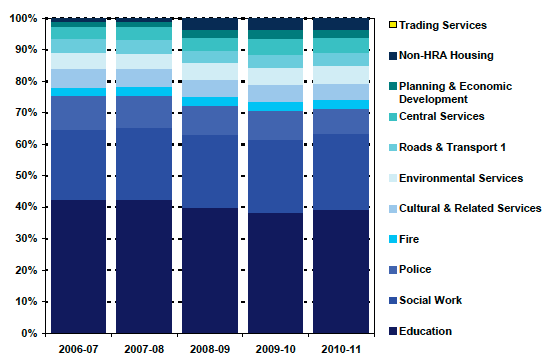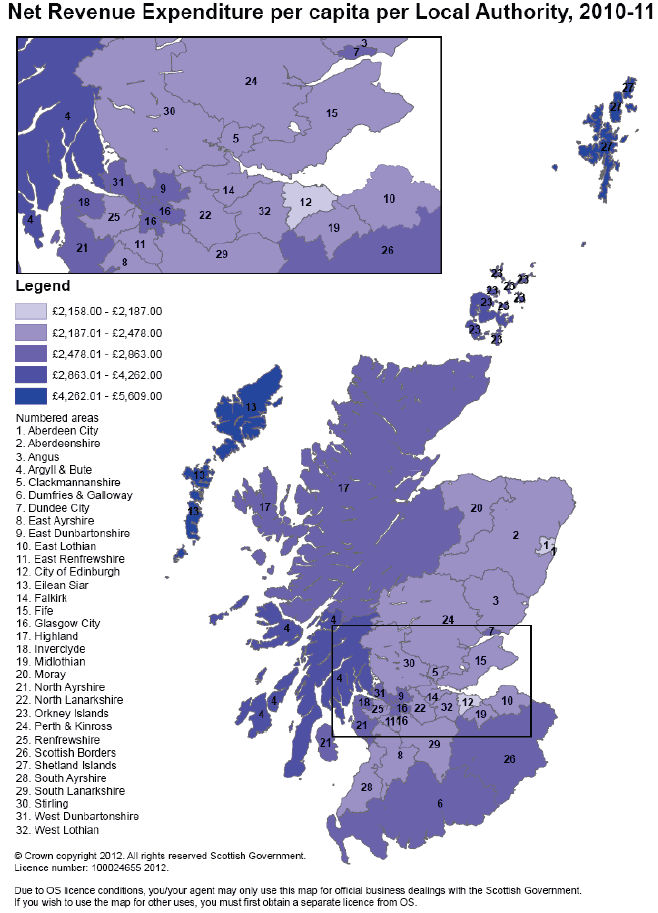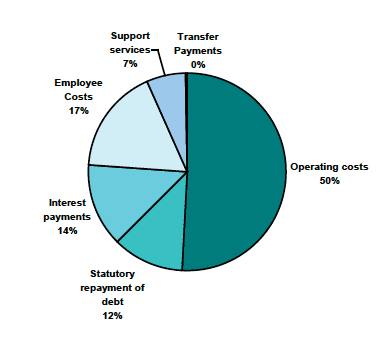Scottish Local Government Financial Statistics 2010-11
A comprehensive overview of Local Authority financial activity
This document is part of a collection
3 - LOCAL GOVERNMENT REVENUE EXPENDITURE
- Total gross revenue expenditure in 2010-11 was £18.5 billion.
- Total General Fund net revenue expenditure to be funded from General Revenue Funding (GRF), council tax and non-domestic rates was £13.0 billion.
- Total revenue reserves at 31 March 2011 were £1.6 billion.
- Housing revenue account gross revenue expenditure was £1.0 billion.
Revenue expenditure covers the costs of maintaining local services and primarily consists of employee costs and operating costs. The benefits of revenue expenditure are received within one financial year. All revenue expenditure, except expenditure on Local Authority housing, is accounted for through the General Fund.
Employee costs include salaries and wages, national insurance and superannuation contributions, cash allowances paid to employees, redundancy and severance payments and other employee costs.
Operating costs include property costs, supplies and services costs, transport (including car allowances) and plant costs, payments to agencies and other bodies, and direct administration costs (including training).
Support Service costs are those paid for services that support the provision of services to the public, e.g. IT, Human Resources, Legal Services, Procurement Services and Corporate Services.
Transfer payments are those made to individuals for which no goods or services are received in return by the local authority.
Revenue Contributions to Capital (RCC) are the revenue contributions towards capital expenditure on capital assets which were met directly from the service revenue within the current year. RCC can also be referred to as capital funded from current revenue (CFCR) in discussions of Capital accounts.
Adjustment for inter-account and inter-authority transfers is an adjustment made for the contributions made by one authority to another, i.e. inter-authority transfers, and the recharges, or income from other accounts within an authority, i.e. inter-account transfers. The adjustment is equal to the total of inter-authority transfers and the total of inter-account transfers.
Grants to third parties funded by General Capital Grant (GCG) come under both revenue and capital expenditure. The General Capital Grant was introduced for the first time in 2008-09. It is a Scottish Government grant paid to the 32 Local Authorities. The grant may be used to fund the capital expenditure of the local authority. With certain limitations, the grant may also be used to fund third party capital expenditure (either through direct spend or the provision of grant). Where the GCG is used to finance the capital expenditure of the council, this expenditure is considered strictly as capital expenditure. Where the GCG is used to fund third party capital projects the GCG is treated as revenue income and the corresponding third-party grant or direct payment is treated as revenue expenditure.
Revised accounting arrangements for Public Private Partnerships (PPP) and Public Finance Initiatives (PFI) were introduced from 1st April 2009. Therefore, from 2009-10 onwards revenue expenditure, statutory repayment of debt and interest and investment income for services in which there are PPP or PFI schemes is not directly comparable with previous years. See section 1.2 for further details.
Gross revenue expenditure is the total expenditure on Local Authority services within a financial year less inter-authority and inter-account transfers.
Net revenue expenditure is gross revenue expenditure, less other government grants, sales, fees and charges, grants to third parties funded by General Capital Grant, and other grants, reimbursements and contributions. It is therefore the net revenue expenditure that is to be financed from General Revenue Funding, non-domestic rates, council tax and balances.
Table 3.1 - Gross Revenue Expenditure, 2010-11
| £ Thousands | |||||
| General Fund Services1 | Housing Revenue Account | Significant Trading Operations | Road Bridges | Common Good Fund | |
|---|---|---|---|---|---|
| Employee Costs | 7,580,561 | 151,164 | 453,258 | 4,075 | 218 |
| Operating Costs | 6,056,339 | 449,303 | 498,898 | 2,225 | 10,358 |
| Support Service Costs | 694,379 | 58,296 | 26,060 | 117 | 370 |
| Transfer payments | 2,239,666 | 1,683 | . | - | 800 |
| Revenue Contributions to Capital | 36,658 | 140,454 | - | 9,856 | 214 |
| Adjustment for inter account and inter authority transfers | -654,297 | -22,664 | -709,787 | - | -3,421 |
| Grants to third parties funded by General Capital Grant | 63,407 | . | . | . | . |
| Statutory Repayment of Debt | 531,490 | 105,190 | 22,378 | 1,440 | 2,633 |
| Interest payments | 615,931 | 122,444 | .. | .. | .. |
| Contributions to General Fund/ Other | . | 1,475 | 7,816 | -554 | 358 |
| Total Gross Revenue Expenditure | 17,164,134 | 1,007,345 | 298,623 | 17,159 | 11,530 |
1. Includes trading services and non-HRA housing. For a breakdown of expenditure in these areas, refer to Table 3.7 and Annexes F and G respectively.
3.1 General Fund Revenue Expenditure5
Table 3.2 - General Fund Revenue Expenditure, 2010-11
| £ thousands | |||||
| Gross Expenditure | Income | Net Expenditure financed from grants, NDR, council tax and balances |
Net exp as % of total services | Ring-fenced Revenue Grants | |
|---|---|---|---|---|---|
| Education | 4,856,964 | 180,450 | 4,676,514 | 39.3% | 21,624 |
| Cultural and Related Services | 738,957 | 100,851 | 638,106 | 5.4% | 12 |
| Social Work | 3,609,012 | 748,260 | 2,860,752 | 24.1% | 2,354 |
| Police | 1,242,866 | 264,657 | 978,209 | 8.2% | 397,102 |
| Fire | 357,138 | 43,643 | 313,495 | 2.6% | - |
| Roads and Transport | 706,996 | 204,366 | 502,630 | 4.2% | 300 |
| Environmental Services | 792,494 | 128,939 | 663,555 | 5.6% | 162 |
| Planning & Economic Development | 512,608 | 199,401 | 313,207 | 2.6% | 2,242 |
| Non-HRA Housing | 2,361,230 | 1,967,327 | 393,903 | 3.3% | 2,962 |
| Central Services | 774,715 | 214,395 | 560,320 | 4.7% | . |
| Trading Services | 61,552 | 69,825 | -8,273 | -0.1% | 123 |
| Total General Fund services | 16,014,532 | 4,122,114 | 11,892,418 | 100.0% | 426,881 |
| Interest and investment income | 615,931 | 26,185 | 589,746 | . | |
| Statutory repayment of debt | 531,490 | . | 531,490 | . | |
| Contributions to/from HRA | 2,181 | . | 2,181 | . | |
| Surplus/deficit from Significant Trading Operations | . | . | -11,105 | . | |
| Total | 17,164,134 | 4,148,299 | 13,004,730 | 426,881 | |
Table 3.3 - Net Revenue Expenditure by Service, 2006-07 to 2010-11
| £ millions | |||||
| 2006-07 | 2007-08 | 2008-09 | 2009-102 | 2010-11 | |
|---|---|---|---|---|---|
| Education | 4,252 | 4,432 | 4,676 | 4,633 | 4,677 |
| Social Work | 2,212 | 2,368 | 2,684 | 2,825 | 2,861 |
| Police | 1,067 | 1,078 | 1,100 | 1,125 | 978 |
| Fire | 280 | 290 | 320 | 332 | 313 |
| Cultural & Related Services | 592 | 593 | 628 | 662 | 638 |
| Environmental Services | 502 | 510 | 628 | 657 | 664 |
| Roads & Transport1 | 447 | 447 | 453 | 486 | 503 |
| Central Services | 392 | 439 | 469 | 632 | 560 |
| Planning & Economic Development | 160 | 163 | 289 | 332 | 313 |
| Non-HRA Housing | 77 | 91 | 427 | 420 | 394 |
| Trading Services | -11 | -12 | -5 | -9 | -8 |
1. Includes Local Authority Transport Undertakings
2. Due to revised accounting arrangements for PPP and PFI, it is not possible to compare net revenue expenditure for 2009-10 with previous years for services in which there are PPP or PFI schemes. The services affected are: Education, Social Work, Culture & Related Services, Environmental Services and Roads & Transport.
Chart 3.1 - Net Revenue Expenditure By Service (%)

1. Due to revised accounting arrangements for PPP and PFI, it is not possible to directly compare net revenue expenditure for 2009-10 with previous years for services in which there are PPP or PFI schemes. The services affected are: Education, Social Work, Culture & Related Services, Environmental Services and Roads & Transport.
2. Roads & Transport includes Local Authority Transport Undertakings.
As identified in Section 1.2, changes in accounting arrangements in 2009-10 for PPP and PFI mean that items relating to financing of PPP and PFI previously included within service expenditure are now recorded in statutory repayment of debt and interest payments. This affects the level of service expenditure when comparing 2008-09 to 2009-10 (and later years), especially in education where most councils have a PPP or PFI scheme in operation.
As mentioned earlier in section 2.1, in the 2008-09 local government finance revenue settlement, many formerly ring-fenced revenue grants were rolled up into General Revenue Funding (GRF). This change in funding can be seen as a larger than usual increase in expenditure from 2007-08 to 2008-09 both in Table 3.3 and in Chart 3.1 above. The Supporting People Grant, the Community Regeneration Fund and the Strategic Waste Fund were three of the largest grants affected by these changes in funding.

3.2 Revenue Expenditure Financing
Net revenue expenditure is funded through grants, non-domestic rates, council tax and balances as shown below in Tables 3.4 and 3.5.
Table 3.4 - Financing of Net Revenue Expenditure
| £ thousands | ||||||
| Net Revenue Expenditure1 | General Revenue Funding2 | Ring-fenced Revenue Grants3 | Council Taxes | NDR | Balances | |
|---|---|---|---|---|---|---|
| 2006-07 | 10,714,001 | 5,777,202 | 888,171 | 1,811,577 | 1,883,769 | 353,282 |
| 2007-08 | 11,119,280 | 6,169,645 | 869,939 | 1,889,913 | 1,859,727 | 330,056 |
| 2008-09 | 12,421,451 | 7,425,886 | 726,350 | 1,908,972 | 1,962,800 | 397,443 |
| 2009-10 | 13,135,372 | 7,756,689 | 761,338 | 1,909,627 | 2,165,100 | 542,618 |
| 2010-11 | 13,004,730 | 8,149,407 | 431,419 | 1,923,186 | 2,068,200 | 432,518 |
1. Includes trading services and non-HRA housing. For a breakdown of expenditure in these areas, refer to Table 3.7 and Annexes F and G respectively.
2. Prior to 2008-09, GRF or General Revenue Funding was referred to as Revenue Support Grant.
3. Prior to 2008-09, Ring-fenced Revenue Grants were referred to as Specific Grants.
Table 3.5 - Financing of Net Revenue Expenditure (%)
| Net Revenue Expenditure1 | General Revenue Funding2 | Ring-fenced Revenue Grants3 | Council Taxes | NDR | Balances | |
|---|---|---|---|---|---|---|
| 2006-07 | 100.0% | 53.9% | 8.3% | 16.9% | 17.6% | 3.3% |
| 2007-08 | 100.0% | 55.5% | 7.8% | 17.0% | 16.7% | 3.0% |
| 2008-09 | 100.0% | 59.8% | 5.8% | 15.4% | 15.8% | 3.2% |
| 2009-10 | 100.0% | 59.8% | 5.8% | 15.4% | 15.8% | 3.2% |
| 2010-11 | 100.0% | 62.7% | 3.3% | 14.8% | 15.9% | 3.3% |
1. Includes trading services and non-HRA housing. For a breakdown of expenditure in these areas, refer to Table 3.7 and Annexes F and G respectively.
2. Prior to 2008-09, GRF or General Revenue Funding was referred to as Revenue Support Grant.
3. Prior to 2008-09, Ring-fenced Revenue Grants were referred to as Specific Grants.
Reserves are generated by accumulating surplus income, which is generally then used to finance future spending on services.
Table 3.6 - Beginning and End of Year Revenue Reserves Levels by Account, 2010-11
| £ thousands | ||||||
| Revenue Reserves | Total Revenue Reserves | |||||
|---|---|---|---|---|---|---|
| General Fund | Housing Revenue Account | Renewal and Repairs | Insurance Fund | Other Statutory Funds | ||
| Level of Reserves held 1 April 2010 | 813,544 | 69,222 | 185,452 | 76,092 | 267,488 | 1,411,798 |
| Level of Reserves held 31 March 2011 | 920,750 | 75,792 | 201,380 | 75,820 | 290,181 | 1,563,923 |
Trading Service accounts cover the finances of Local Authority operated services that are commercial in nature. They are financed by the charges made by a Local Authority to the recipients of the services they provide.
The main trading services are Local Authority Transport (buses, ferries and other Local Authority transport undertakings), Fishery harbours and markets and other trading services (including airports, other harbours and bridges).
From 2008-09, the funding arrangements for the Forth and Tay Bridge authorities changed. Under the Abolition of Bridge Tolls (Scotland) Act 2008, the bridge authorities stopped receiving income from tolls and, instead, started receiving a revenue grant from Transport Scotland. For capital expenditure, bridge authorities also started receiving a capital grant from Transport Scotland, so are no longer reliant on borrowing through their constituent authorities from the Loans Fund. Despite this change in funding, Local Authorities continue to provide services for the bridge authorities by way of contract.
Table 3.7 - Trading Service Revenue Expenditure and Income by Service, 2010-11
| Passenger Transport1 | £ thousands | ||||||
|---|---|---|---|---|---|---|---|
| Buses | Ferries | Other transport undertakings | Road bridges | Fisheries, harbours and markets2 | Other trading services2 | Total External Trading | |
| Expenditure | |||||||
| Employee costs | 704 | 8,452 | 1,258 | 4,075 | 1,944 | 25,588 | 42,021 |
| Operating expenses | 556 | 16,326 | 3,016 | 1,671 | 17,765 | 27,012 | 66,346 |
| Revenue contributions to capital | . | . | . | 9,856 | 29 | - | 9,885 |
| Support service costs | 46 | 297 | 147 | 117 | 326 | 2,013 | 2,946 |
| Grants to third parties funded by General Capital Grant | - | - | - | - | - | 22 | 22 |
| Adjustment for inter account and inter authority transfers | -1,029 | 0 | -5,191 | 0 | -33 | -13,114 | -19,367 |
| Total expenditure | 277 | 25,075 | -770 | 15,719 | 20,031 | 41,521 | 101,853 |
| Income | |||||||
| Government grants | 133 | 12 | - | 1,282 | 146 | - | 1,573 |
| Sales, rents, fees and charges | 225 | 5,600 | 83 | 89 | 19,908 | 46,944 | 72,849 |
| Other income | 200 | 76 | - | 15,297 | - | 2,805 | 18,378 |
| Grants to third parties funded by General Capital Grant | - | - | - | - | - | 22 | 22 |
| Total income | 558 | 5,688 | 83 | 16,668 | 20,054 | 49,771 | 92,822 |
| Ring Fenced Grants | 0 | 0 | 0 | . | . | 123 | 123 |
1. Included under Roads & Transport in service level breakdowns
2. Included under Trading Services in service level breakdowns
The Housing Revenue Account (HRA) records income and expenditure relating to Local Authority housing stock. Whilst most other Local Authority services are funded through a combination of non domestic rates and council tax income plus Government grants, the HRA is a ring-fenced account, and expenditure is funded by housing rents and Government subsidies.
Table 3.8 - Housing Revenue Account Expenditure and Income, 2010-111
| £ thousands | |
| Expenditure | |
|---|---|
| Employee Costs | 151,164 |
| Operating costs | 449,303 |
| Transfer Payments | 1,683 |
| Support services | 58,296 |
| Statutory repayment of debt | 105,190 |
| Interest payments | 122,444 |
| Total Expenditure2 | 888,080 |
| Total Gross Revenue Expenditure2 | 1,007,345 |
| Income | |
| Sales, rents, fees and charges | 979,571 |
| Government Grants | 9,213 |
| Other Income | 2,309 |
| Interest and investment income | 1,260 |
| Inter-Account and Inter-Authority Transfers | 22,664 |
| TOTAL INCOME | 1,015,017 |
| Net expenditure on housing | -126,937 |
| Revenue contribution to capital | 140,454 |
| Net expenditure after contribution to capital | 13,517 |
| Contributions from the General Fund | 2,181 |
| Contributions to the General Fund | 1,475 |
| Surplus retained on HRA | 17,173 |
1. Includes leasing charges
2. The total expenditure breakdown represents the way HRA is recorded in local authority accounts. The total gross revenue expenditure figure is included to ensure consistency with the HRA expenditure breakdown in table 3.1 which provides a comparison with other accounts.
Chart 3.2 - Housing Revenue Account Expenditure, 2010-11

Common Good Fund income and expenditure is recorded in a separate set of accounts. Some property held within a Local Authority's Common Good Fund can be sold, while some must be maintained in trust for the community. The fund is used for projects that are for the common good of all residents.
Table 3.9 - Common Good Fund Expenditure and Income, 2010-11
| £ thousands | |
| Expenditure | |
|---|---|
| Employee Costs | 218 |
| Operating Expenses | 10,358 |
| Support Service Costs | 370 |
| Other Expenditure | 358 |
| Revenue Contributions to Capital | 214 |
| Transfer Payments | 800 |
| Loan Charges | 2,633 |
| Adjustment for inter account and inter authority transfers | -3,421 |
| TOTAL EXPENDITURE | 11,530 |
| Income | |
| Sales, fees and Charges | 7,168 |
| Investment Income | 3,157 |
| Other Income | 353 |
| TOTAL INCOME | 10,678 |
Contact
Email: Bruce Golding
There is a problem
Thanks for your feedback